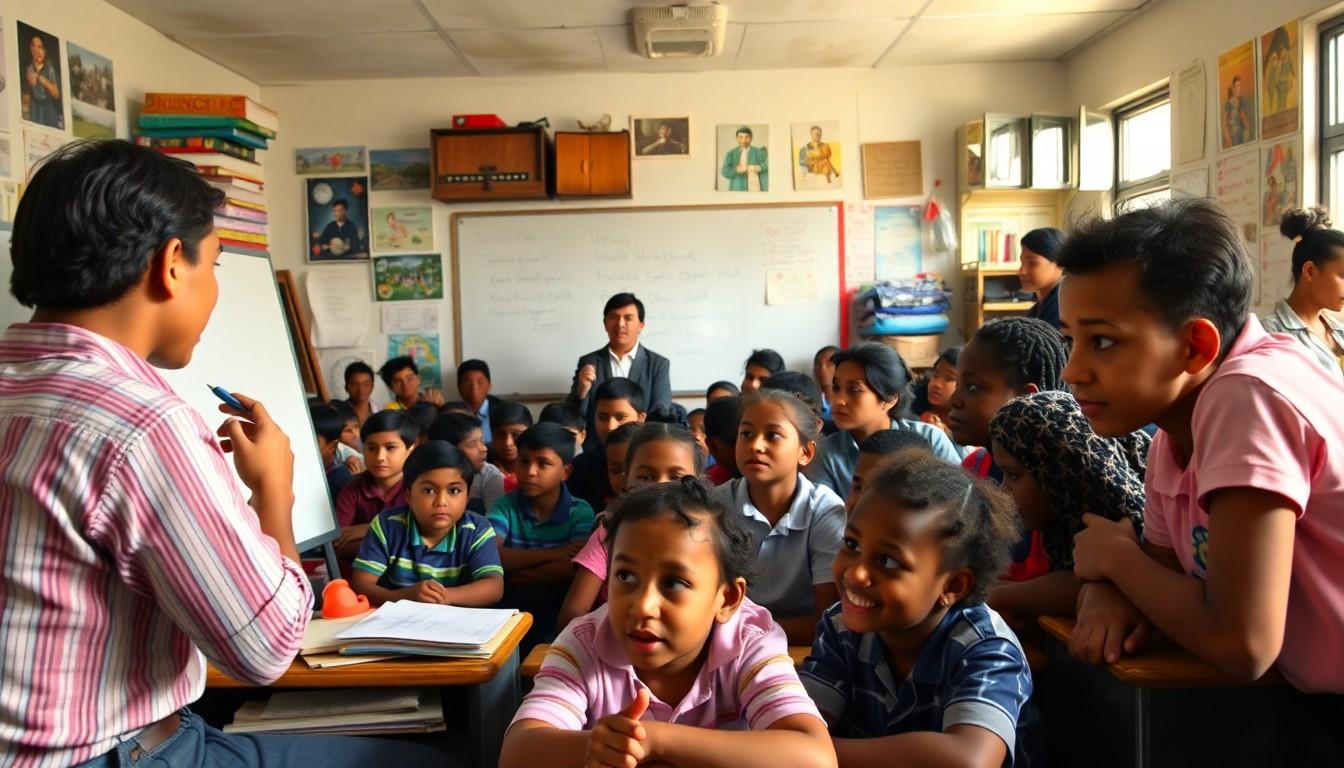Phone:
(701)814-6992
Physical address:
6296 Donnelly Plaza
Ratkeville, Bahamas.

In today’s fast-paced world, K-12 education faces challenges that could make even the most seasoned teacher raise an eyebrow. From budget cuts that feel like a bad magic trick to the ever-growing debate on standardized testing, the landscape is as unpredictable as a cat on a hot tin roof. Parents, educators, and students alike are navigating a maze of issues that require more than just a good sense of direction.
But fear not! This isn’t just a tale of woe. The current issues in K-12 education also spark conversations that can lead to innovative solutions. Whether it’s the push for technology in classrooms or the quest for mental health support, there’s plenty to discuss. Buckle up as we dive into the quirks and quandaries of modern education, where every challenge could be the spark for a brighter future.
K-12 education faces significant challenges today. Budget cuts threaten programs and resources, forcing districts to make difficult choices. In many areas, teachers contend with larger class sizes and fewer materials. Standardized testing remains a contentious issue, with debates over its effectiveness and impact on student learning.
Mental health support holds increasing importance, as more students struggle with anxiety and depression. Schools often lack sufficient resources or trained personnel to address these needs appropriately. Technology integration presents opportunities and obstacles, with access disparities becoming more pronounced. Rural and low-income students frequently experience limited access to digital tools.
Equity in education garners attention, highlighting the need for systemic changes. Diverse student populations require tailored approaches to learning and support. Educators strive to adapt curricula that resonate with all students while fostering inclusivity.
Parental involvement in education also poses challenges. Some parents face barriers to engagement due to work commitments or educational disparities. This disconnect can create a divide between home and school, impacting student success.
Furthermore, teacher retention becomes a pressing issue as burnout and dissatisfaction increase. Supporting educators with professional development and mental health resources is essential for maintaining a strong workforce. Policies that prioritize teacher well-being can lead to improved student outcomes.
Addressing these current issues provides an opportunity for meaningful dialogue among policymakers, educators, and communities. Collaborative efforts can drive innovative solutions, ensuring K-12 education evolves to meet the needs of all students.

Funding challenges significantly impact K-12 education. Budget cuts continue to constrain resources, making it harder for schools to achieve equity.
Inequities in funding persist across districts. Wealthier areas often receive more financial support than low-income counterparts. Schools in affluent districts access additional programs, advanced technologies, and extracurricular activities. Meanwhile, underfunded schools frequently grapple with basic resource shortages, impacting their ability to provide quality education. Federal funding disparities further exacerbate these issues, leaving some students without equitable opportunities.
Educational quality often suffers due to funding shortages. Smaller budgets result in larger class sizes, hindering personalized instruction. Teacher salaries stagnate, leading to increased turnover rates and burnout among educators. Students in struggling schools miss out on extracurricular programs, counseling services, and updated materials, creating a gap in overall educational experiences. Ultimately, these factors contribute to declining student performance and limited future opportunities.
Curriculum and standards face scrutiny in today’s K-12 education landscape. Debates frequently arise around what content students should learn and how it should be delivered.
Curriculum content often sparks debates among educators, parents, and policymakers. Detractors of standard curricula argue that they fail to represent diverse perspectives and cultural backgrounds. Proponents believe these standards promote consistency and equity in education. The push for inclusive educational materials reflects growing awareness of the need for diverse perspectives in classrooms. Additionally, integrating current events into the curriculum can enhance student engagement by making learning relevant. Some districts have started to adopt curricula that align better with students’ lived experiences and community values.
Standardized testing continues to play a significant role in K-12 education. Critics argue that these tests narrow the curriculum and lead to teaching to the test, limiting creativity in instruction. Data shows students in high-stakes testing environments often experience increased anxiety, impacting their performance. Advocates assert that standardized tests provide valuable data for evaluating student progress and school effectiveness. However, many educators call for a re-evaluation of how these assessments are used, emphasizing a need for more comprehensive measures of student achievement. Innovative assessment strategies, including performance-based assessments, are gaining traction as alternatives that better reflect student learning.
Technology integration in K-12 education presents both advantages and hurdles. Many educators embrace educational technology (EdTech) for its potential to enhance learning experiences and engagement.
EdTech offers several advantages, including personalized learning and improved access to resources. Teachers can tailor lessons to match individual student needs, fostering a more inclusive environment. Interactive tools like educational apps and online platforms increase student engagement, making learning more appealing. Additionally, online resources provide access to a wealth of information and free materials, which can be especially beneficial for low-income students. Collaboration is another key aspect, as technology facilitates communication between students, teachers, and parents, promoting a supportive learning community.
Implementing technology in classrooms often presents significant challenges. Budget constraints hinder schools’ ability to acquire necessary devices and infrastructure, particularly in low-income areas. Professional development for teachers is essential, yet many staff members lack adequate training on how to effectively integrate technology into their curriculum. Digital equity remains a concern, as not all students have equal access to devices or internet connectivity, leading to disparities in learning opportunities. Resistance to change and varying levels of tech proficiency among educators can further complicate the adoption of new technologies, impacting the overall effectiveness of integration efforts.
Teacher shortages present a critical challenge in K-12 education today. Many factors create this issue, affecting schools nationwide.
Budget cuts lead to larger class sizes, increasing the workload for remaining educators. Burnout has skyrocketed, fueled by inadequate support and high-stakes testing pressures. Moreover, low salaries fail to attract new talent, driving many teachers to seek careers in other fields. Staffing vacancies rise when new educators enter with insufficient training and mentorship. Additionally, fewer individuals pursue teaching degrees, as college enrollment decreases and alternative career options become more appealing. Public perception often undermines teaching as a profession, making it less attractive.
Schools must prioritize mental health resources to support educators effectively. Professional development that focuses on practical strategies enhances teaching skills and job satisfaction. Competitive salaries and incentive programs can attract and keep qualified teachers. Flexible schedules promote a healthy work-life balance, helping reduce burnout rates. Creating a supportive community among staff fosters collaboration and camaraderie, improving retention rates. Leadership must value and recognize teacher contributions, creating a culture of appreciation. Engaging educators in decision-making processes empowers them, contributing to their commitment and investment in their roles.
Mental health support is essential in K-12 education. Concerns around anxiety and depression among students have risen. Schools must prioritize addressing these needs through comprehensive support systems.
Counseling services need expansion in schools. Access to mental health resources helps students cope with stress. Programs that promote emotional well-being offer students tools to manage challenges. Collaboration with community organizations can enhance support networks. Training for staff on mental health awareness fosters a nurturing environment.
COVID-19 significantly disrupted student well-being. Isolation during remote learning increased stress levels among students. Many faced challenges such as lack of social interaction and academic pressures. Schools observed a rise in mental health issues, necessitating urgent attention. Implementing a hybrid learning approach may address these concerns while providing flexibility.
Navigating the current landscape of K-12 education presents significant challenges that require immediate attention and innovative solutions. Addressing issues like funding disparities, mental health support, and teacher retention is crucial for fostering an equitable educational environment.
As stakeholders engage in meaningful dialogue, the potential for transformative change becomes apparent. By prioritizing diverse learning approaches and embracing technology, schools can create inclusive spaces that cater to all students.
Ultimately, the commitment to improving K-12 education will shape the future of countless learners, ensuring they have access to the resources and support needed to thrive.